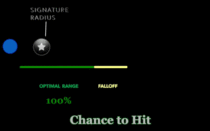More actions
colored text
- use colon to indent a line in a list
| Header text | Header text | Header text |
|---|---|---|
| Example | Example | Example |
---=========================
Quick Overview
Fighting in space is a matter of physics. The detailed chart below is based on physics but doesn't show it. The math in Turret Mechanics and Missile Mechanics does show it. You can find it there if you want it - some do; some don't.
- If a target is standing still, you can hit it with anything. (The same is true of you … so keep moving.)
- Turrets fire a stream of stuff - pellets, pulses, ray beams - in a straight line.
- Missiles home in on their targets.
Turrets fire a stream of stuff - pellets, pulses, ray beams - in a straight line.
- -Individual loads miss a lot - but there are a lot of loads
- -reach their targets quickly
- -fire and reload fast
- Projectiles: use no capacitor, all damage types, cheapest ammo
- Hybrids: use some capacitor, two damage types
- Energy: use a lot of capacitor, two damage types, no reloading
Missiles home in on their targets.
- -Each hit always does some damage - they almost always hit.
- -They take a long time to reach their target.
- -They fire and reload slowly.
If you want a bit more

Turrets turn; missiles chase.
Missiles depend on range. Beyond maximum range, they do no damage.(But remember, missiles are slow; you can outrun them.)
Turrets depend on tracking and range. Optimal range is the place where you have the best chance to hit - not guaranteed, just best odds. The optimal range plus the falloff distance gives you the place where you have a 50% chance to hit.
Tracking is how fast the turret spins. Faster is better.
